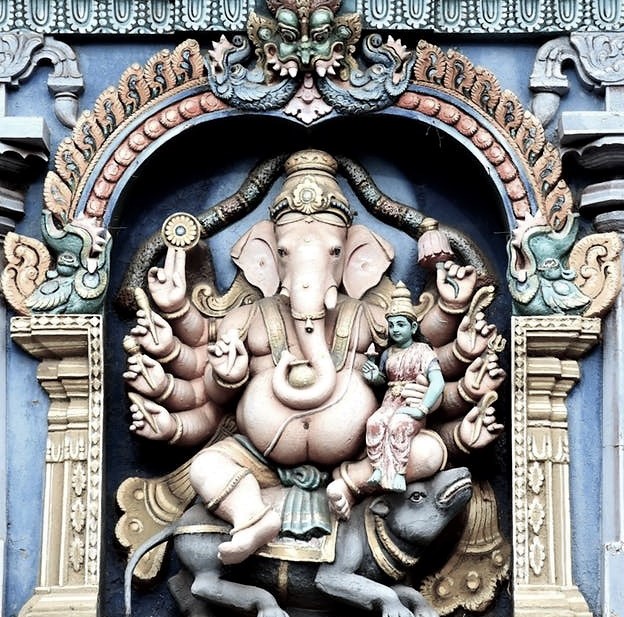- Special FeaturesFoundation Year18th century ADSthala TreeTheerthamRathamArchitectureKerala Temple ArchitectureOther Speciality(Divya Desam)
- Sthala Puran
Tirunavaya Temple is a historically significant ancient Hindu temple on the banks of the River Bharata dedicated to Nava Mukundan Vishnu with the other deities like Ganesha, and Lakshmi. It is located near the ancient Hindu pilgrimage centre of Tirunavaya, a village 8 km south of Tirur in the Malappuram district of Kerala state, India. The temple was the traditional venue for the historic ritual of the Mamankam festival, an enactment of traditional martial arts by suicide squads.
From ancient times Thirunavaya was known throughout India as a centre of excellence for Vedic teachings, with Veda Paadda Saalas (Thirunnavaya Otthanmmar Maddom) for teaching the Vedas, Sasthras, Tantric Mantras, performing of rituals and preaching under learned scholars. (Recently these were shifted to Cheru Thirunnavaya, a centre on the South bank of Bharathapuzha).
The Vaishnava sect of Hindus have 108 Thiruppathis (most holy temples) and eleven of them are now in Kerala and Thirunavaya is one among them. It was on the sandy ridges and outskirts of Bharatapuzha that the glorious magnum event MAMANKAM was conducted once in every 12 years.
This temple was constructed about 5000 years back. Though it had undergone periodical renovations, the last and major renovation with the reconstruction of Sanctum Sanctorum was done by the legendary PERUMTHACHAN under the direction of the Vettath Raja about 1300 years back. The reconstruction had the typical ' Perumthachan touch ' making the rays of the rising sun fall on the idol on every Medam First ( in Utharaayana period, ie in April) and on Kanni First,(in Dakshinayana period ie, in October).
This temple, 'The Navamukunda Temple' is one of the oldest Vishnu temples in Kerala. It dates back to the last period of the 'Dwaapara Yuga'.
Thirunavaya was once the capital of Perumpadapu Swaroopam. It is indeed the cradle of culture in northern Kerala. Holding immense historical importance, this is the place where 'Mamangam', a grand assembly of the rulers of Kerala was held once every 12 years, in olden times. This extravagant festival was held for the last time in 1755 AD. The famous and ancient Thirunavaya Temple, known throughout the country as an ancient teaching-centre of the Vedas, was once plundered and destroyed by Tipu Sultan's army. It was the Zamorin who repaired the temple later.
This is the place were Nava yogis (Sathuvanathar, Saaloga nathar, Aadhinathar, Arulithanathar, Madhanga Nathar, Macchendira Nathar, Kadayanthira Nathar, Korakkanathar and Kukkudanathar) worshipped Vishnu. Vishnu gave darsan for Nava yogi. Hence this place is called Thirunavayogi and later changed in to Thirunaavaya.
- Architecture
The present temple is built in Kerala Temple Architecture style, which is almost common in all temples in Kerala.
- Alankar of Deity
- Prayers and BenefitsSpecial Vratas and PrayersOfferings to Deity
The main daily offerings for worship are Ney Vilakku (lamp lighted with ghee), Thaamara maala ( Lotus garlands) and Paal paayasam (Porridge/Dessert or Kheer made of rice cooked in sweetened milk). For unhindered availability of lotus flowers, one of the Maharajas of Travancore had constructed a vast pond of lotus plants nearby, and donated it to this temple.
Each and every person arriving at the temple during the entire year, is provided with free meals which is known as 'Prasada Oottu' or 'Annadaanam' which is one of the most important Vazhipadu.
Stotras and Mantras
- FestivalsMamankam festival celebrated in the temple was the most prominent festival in Kerala in the Middle Ages.Devotees perform prayers for their separated souls (pitrs) in the banks of the River Ponnani in the temple.The major religious practices are Naivilakku, Thamara mala, Palpayasam, Malar pala and Thali Charthal.
- Sodasha Upcharas
- Prasadhas
- Social ActivitiesAnnadhanMarriageEar BoringHead ShaveDanaasEducation FacilitiesSocial DrivesOther Activities
- Arjita Seva
- Tags

